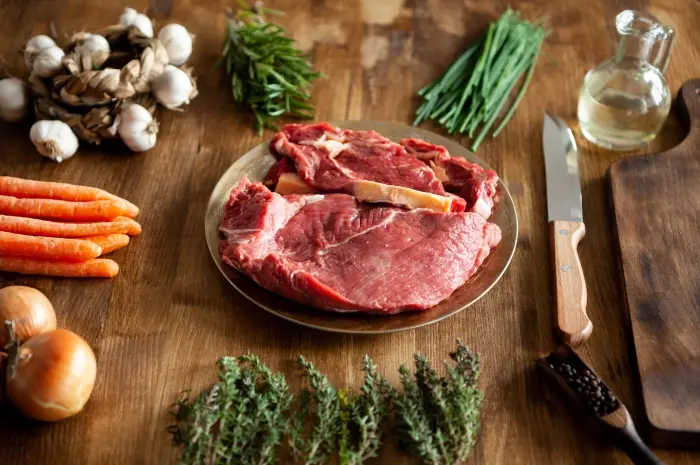As more people become conscious about what goes on their plates, the rise of organic food stores and natural grocery options reflects a growing shift toward healthier, more mindful eating habits. One food item that’s often debated in health and wellness circles is beef.
While it’s frequently criticized due to associations with processed meat and environmental concerns, the reality is more nuanced – especially when you consider grass-fed and organic beef.
If you’re someone who’s trying to reduce processed foods and make smarter dietary choices, not all beef is created equal.
Understanding the difference between conventional, organic, and grass-fed beef can help you make more informed choices – and enjoy your favorite dishes without compromising your health.
The Problem with Conventional Beef
Most beef sold in large chain grocery stores comes from cattle raised on conventional feedlots. These cows are typically fed grain-based diets (primarily corn and soy), which are not part of their natural intake.
The goals of this feeding system are to fatten cattle quickly and reduce costs, but this approach comes at a price:
- Lower nutritional value in the meat
- Higher levels of saturated fats and omega-6 fatty acids
- Use of antibiotics and growth hormones
- Exposure to pesticides and chemical-laden feed additives
As public awareness of these issues grows, many consumers are choosing to seek out healthier alternatives.
Grass-Fed Beef: A Return to Nature
Cattle are natural grazers, and their bodies are designed to eat grasses, not grain. Grass-fed beef comes from cows that are allowed to roam on pastures and feed on grass for the majority of their lives.
This natural diet leads to numerous health and environmental benefits:
Health Benefits of Grass-Fed Beef:
- Higher in Omega-3 fatty acids: These heart-healthy fats support brain function and reduce inflammation.
- Richer in CLA (conjugated linoleic acid): A beneficial fat linked to improved metabolism and immune function.
- More antioxidants: Including vitamin E and beta-carotene, which support skin and immune health.
- Better fat composition: Less total fat, and a healthier fat profile overall.
By choosing grass-fed beef, you’re not just getting a cleaner protein source – you’re also supporting better animal welfare and sustainable agriculture practices.
Organic Beef: A Cleaner, Regulated Alternative
While grass-fed refers mainly to the cow’s diet, organic beef is governed by strict USDA guidelines covering every aspect of the animal’s life. For beef to carry the USDA Organic label, it must:
- Come from animals raised without antibiotics or synthetic growth hormones
- Be fed 100% organic feed (which may include organic grains or grass)
- Have access to the outdoors and pasture, allowing for natural behaviors
- Be raised in environmentally responsible conditions that support sustainability
Organic beef may not always be grass-fed (unless specified), but it’s still a far superior alternative to conventional beef due to the absence of chemicals, hormones, and genetically modified feed.
Grass-Fed vs. Organic Beef: What’s the Difference?
| Feature | Grass-Fed Beef | Organic Beef |
|---|---|---|
| Diet | Grass and forage only | Organic feed (may include organic grains) |
| Antibiotics/Hormones | Usually not used (check label) | Strictly prohibited |
| Access to Outdoors | Required for grazing | Required |
| Certification Requirement | Not regulated by USDA (unless labeled) | USDA Certified Organic |
| Nutritional Benefits | Higher in omega-3, CLA, antioxidants | Healthier than conventional, varies by feed |
| Price | Typically higher than conventional | Slightly higher than grass-fed or conventional |
Best Case Scenario: Choose beef that is both grass-fed and organic for maximum nutritional value and ethical sourcing.
Why You Don’t Need to Quit Red Meat
Despite what some headlines suggest, red meat doesn’t have to be unhealthy – especially when you make mindful choices.
Grass-fed and organic beef provide a nutrient-rich protein source without the drawbacks of conventional meat. When eaten in moderation as part of a balanced diet, beef can offer:
- Iron for energy and red blood cell production
- Zinc to support immunity
- Vitamin B12 for brain and nerve health
- Protein for muscle growth and repair
Yes, It Costs More – But It’s Worth It
It’s true: organic and grass-fed beef is often more expensive. But what you’re paying for is:
- Better nutrition
- Safer, chemical-free consumption
- Higher animal welfare standards
- Greater environmental sustainability
Think of it as an investment in your long-term health.
There’s no need to give up beef if you’re aiming for a healthier lifestyle – just choose smarter.
Opt for grass-fed or certified organic beef, and you’ll gain all the benefits of high-quality protein without the risks associated with heavily processed, chemically treated meat.
So next time you’re at the grocery store or farmers market, take a moment to read the labels. Your body – and the planet – will thank you.








